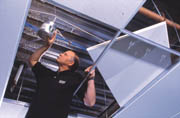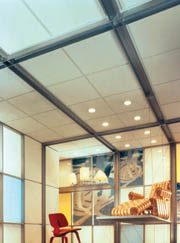All trends bring about winners and losers. And those confronted with the challenges of acoustics in today's open-office designs are no different.
The good news for building owners is that they can realize lower build-out costs in open-plan offices. But for tenants, as well as the architects and designers who lay out these spaces, the news is mixed.
Commercial tenants may realize more affordable rents in open-plan offices but the noise and distractions inherent in these offices can hinder worker productivity. Cell phones, computers, speaker phones, fax machines, and casual meetings and conversations in nearby cubicles disturb employee concentration throughout the day.
While the open-plan office is designed to encourage interaction and collaboration, noise from even casual conversations nearby can be overwhelming and distracting. According to an industry study by Bosti Associates, striking a balance between interaction and independence is key to maximizing comfort and productivity.
Specifically, the Bosti study showed that "the two workplace qualities with the strongest effects on performance and satisfaction are those supporting distraction-free work and supporting interactions with co-workers. Both of these top workplace design priorities must exist without compromising the other."
Still other studies have shown that it takes 15 to 20 minutes for workers to regain concentration following a noise distraction. Obviously, open-office distractions can have a significant-and costly-impact for business managers. In turn, building owners must cope with potentially higher tenant turnover and even reduced property values resulting from acoustically inferior office spaces. These issues create a dilemma for designers, who are being asked to create open office spaces where there are no doors and few, if any, floor-to-ceiling partition walls.
However, this dilemma also creates opportunities for contractors to incorporate a value-added sound masking component into their scope of services. By contacting and working with a local sound masking manufacturer, contractors should be able to demonstrate to the building owner the effectiveness of a properly designed and installed professional sound-masking system.
Sound-absorbing ceiling panels, carpeting and relocatable partition walls can provide varying levels of sound control but open-office acoustical issues usually cannot be solved without professional sound masking.

What is sound masking?
Sound masking introduces an unobtrusive, ambient background sound into open spaces and other areas using speakers installed in the plenum above a suspended ceiling. The technology has advanced tremendously since the days of simple white noise machines. Good sound masking systems are very soothing, producing a gentle sound spectrum that masks noise, speech and distracting sounds. Recent advancements have made these systems more highly effective than ever in both open- and private-office environments.The masking is non-directional, harmoniously uniform and can be easily adjusted to meet a variety of conditions and privacy needs. Usually, the masking level needs to be three decibels louder than incoming speech from adjacent workstations.
Sound masking works by producing a unique digital broadband sound spectrum complementary to the spectrum that effectively covers speech levels. The sound is amplified through individual speakers that are typically set every 15 feet or so above a dropped ceiling. The sound then filters down through ceiling panels and into the office space, providing a constant level of background sound that covers up office noise and lessens the intelligibility of speech. Sound masking technology has proven to increase worker output by anywhere from three to 20 percent (see sidebar below).
There are two basic types of sound-masking systems:
One type uses speakers that point directly down onto the workspace. However, this set-up can create "hot" and "cold" spots throughout the office area, meaning that the system can be effective in certain areas and not effective, as well as intrusive and distracting, in other areas.
Most acoustical consultants agree that a better approach is to direct sound upward, into the ceiling plenum. This allows the masking noise to bounce off the floor/ceiling slab and re-enter the office space after being filtered by the ceiling panel similar to the way ambient light evenly lights a room. This lets each unit's sound overlap nearby units, creating an even, equally effective sound level throughout the space.

Costs and Installation
Experts say more than 99 percent of all corporate offices can benefit from masking.Contractors who want to offer value added sound masking to clients need to do the following: First, identify the client's need for better acoustics. Ask them to consider these questions:
• Will these employees need speech privacy and confidentiality? Will the work environment be as productive and pleasant as possible? Have they eliminated private offices?
• Would productivity, efficiency and morale be lifted if there were fewer distractions in the office?
After identifying the need, secure a copy of the furniture and ceiling plan for the space. Then determine the following:
• What type of ceiling does the client have (acoustical ceiling panels, gypsum board, open/exposed)?
• What is the approximate ceiling height (8 to 10 feet, 12 feet, 16 feet or more)?
• Approximately what height is the plenum area (1 foot 3 feet, 6 feet or more)?
• Are there other acoustical properties in the space (carpet, partitions, ceilings, acoustical wall panels)?
• Is the client interested in a paging/music system in addition to the masking?
Once these questions are answered, consult a sound masking manufacturer so that a sound-masking plan can be designed for the space.
An average sound-masking project can be budgeted at $1 to $1.50 per square foot, furnished, delivered and installed, depending on size, scope and location. Employee productivity increases generally offset the client's initial costs.
Dynamic Duo
For best acoustical performance in open-office environments, sound-masking systems should be installed with acoustical ceiling panels that deliver a high noise reduction coefficient. This makes cast ceiling panels an ideal choice. Not only do cast panels deliver excellent NRC performance but they also provide high ceiling attenuation class performance, which is desirable for closed- or private-office spaces.For NRC and CAC, cast panels are the best option, because many open office environments include private-office spaces as well. Cast ceilings provide a great solution, are exceptionally durable, and have the ability to withstand use and abuse resulting from plenum access without scratches or nicks. So, should the need arise to reconfigure sound masking within the plenum, there's no need to worry about panel damage.
